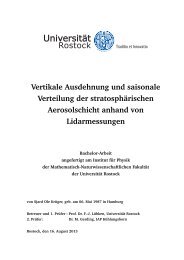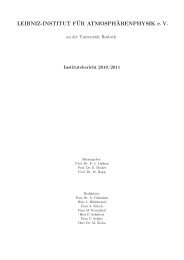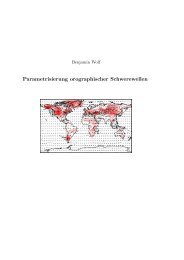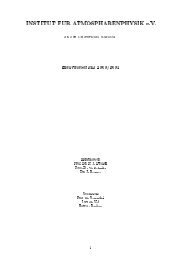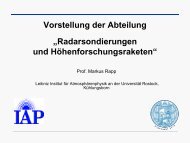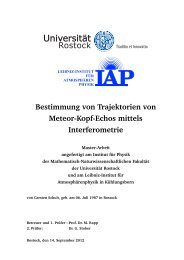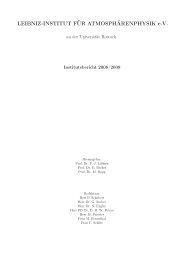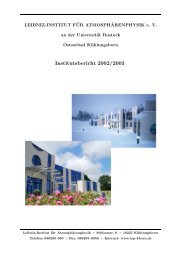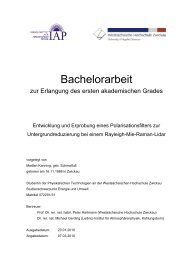Polar mesosphere summer echoes (PMSE): review of ... - HAL
Polar mesosphere summer echoes (PMSE): review of ... - HAL
Polar mesosphere summer echoes (PMSE): review of ... - HAL
You also want an ePaper? Increase the reach of your titles
YUMPU automatically turns print PDFs into web optimized ePapers that Google loves.
M. Rapp and F. J. Lübken: Review <strong>of</strong> <strong>PMSE</strong> 2627<br />
current manuscript, Doppler spectral width measurements in<br />
<strong>PMSE</strong> further allow for a near continuous characterization<br />
<strong>of</strong> mesospheric turbulence which is a significant contribution<br />
to the energy budget at these altitudes with corresponding<br />
heating rates in excess <strong>of</strong> the radiative input. Finally, apart<br />
from its obvious importance for the study <strong>of</strong> the Earth’s middle<br />
atmosphere, <strong>PMSE</strong> further allow to study basic physical<br />
processes with significance far beyond atmospheric physics:<br />
Being caused by the transport <strong>of</strong> charged particles, electrons<br />
and positive ions due to the turbulent velocity field, the study<br />
<strong>of</strong> <strong>PMSE</strong> also allow insights into the characteristics <strong>of</strong> turbulence<br />
itself and the behaviour <strong>of</strong> complex plasmas which are<br />
both areas <strong>of</strong> current intensive research.<br />
Outlook<br />
As far as future work on <strong>PMSE</strong> is concerned we see the<br />
following promising areas:<br />
1.) Simultaneous and continuous observations <strong>of</strong> mesospheric<br />
turbulence strength (for example with a narrow beam<br />
MF radar as introduced by Hocking, 1983, and recently<br />
further developed by Latteck et al., submitted, 2004 5 ),<br />
<strong>PMSE</strong> (observed with a VHF radar) and aerosol particles<br />
sizes (with a multi-color lidar) should be conducted in<br />
order to check the above described scenario with frequent<br />
turbulent activity and small ice particles in the upper portion<br />
<strong>of</strong> the <strong>PMSE</strong> layer and only occasional turbulent activity but<br />
large ice particles in the lower part <strong>of</strong> the layer. The same<br />
experiment could also yield useful data to check the relation<br />
between spectral width in <strong>PMSE</strong> and turbulent activity.<br />
2.) The recently performed active experiments to modify<br />
<strong>PMSE</strong> with a powerful HF-heater are very promising and<br />
should be further continued and expanded in the future. As<br />
pointed out by Havnes et al. (2003), such experiments have<br />
the potential to teach us more details about the charging<br />
characteristics <strong>of</strong> the ice particles, as well as intrinsic<br />
properties <strong>of</strong> the particles themselves (like radii and number<br />
densities) and the background ionosphere.<br />
3.) Only very little is known so far about the degree <strong>of</strong><br />
isotropy <strong>of</strong> mesospheric turbulence as well as its horizontal<br />
homogeneity. Indications for anisotropy and horizontal<br />
inhomogeneity come from the details <strong>of</strong> radar Doppler<br />
spectra (see Sect. 2.3.2), the observed aspect sensitivity<br />
(see Sect. 2.3.3), and comparisons between electron number<br />
density pr<strong>of</strong>iles and <strong>PMSE</strong> (see Rapp et al., 2003a). In order<br />
to study these issues, sounding rocket payloads carrying<br />
several small ‘daughter’ payloads should be developed that<br />
are to be ejected from the main payload during the traverse<br />
5 Latteck, R., Singer, W., and Hocking, W. K.: Measurement <strong>of</strong><br />
turbulent kinetic energy dissipation rates in the <strong>mesosphere</strong> by a<br />
3 MHz Doppler radar, Adv. Space Res., submitted, 2004.<br />
<strong>of</strong> a <strong>PMSE</strong> layer and hence yield a horizontal picture <strong>of</strong><br />
the turbulent irregularity field. First attempts have been<br />
made before (Blix and Thrane, 1985), however, at that time<br />
experiments were just at the edge <strong>of</strong> feasibility. Today, the<br />
miniaturization <strong>of</strong> electronics allows for a much more robust<br />
design <strong>of</strong> such rocket probes so that the success-rate should<br />
be much better than during previous attempts.<br />
4.) Regarding the microphysics <strong>of</strong> the involved ice<br />
particles the most important remaining open question is<br />
about the actual origin <strong>of</strong> the ice particles. It has long been<br />
assumed that the ice particles nucleate on meteoric smoke<br />
particles, however, direct experimental evidence for the<br />
existence <strong>of</strong> these particles is not available. In order to<br />
confirm the existence <strong>of</strong> these nuclei, Rapp et al. (2003d)<br />
have recently proposed a rocket experiment that is based<br />
on the idea to charge the particles photo-electrically by<br />
the radiation <strong>of</strong> a UV-flashlamp and subsequently detect<br />
them by a sensitive electrometer. Should this attempt be<br />
successful, further work should be done in order to identify<br />
the composition <strong>of</strong> the particles and their creation through<br />
the ablation <strong>of</strong> meteorides in the mesopause region and the<br />
subsequent microphysical processes.<br />
5.) Both from rocket borne experiments (Mitchell et al.,<br />
2001; Croskey et al., 2001; Chesworth and Hale, 1974) and<br />
from the observation <strong>of</strong> so called polar <strong>mesosphere</strong> winter<br />
<strong>echoes</strong> (Kirkwood et al., 2002a, 2003) evidence is emerging<br />
for the existence <strong>of</strong> aerosol particles throughout the entire<br />
<strong>mesosphere</strong> during all times <strong>of</strong> the year. At altitudes below<br />
80 km and outside the <strong>summer</strong> season temperatures are far<br />
to warm to allow for the existence <strong>of</strong> ice particles (Lübken,<br />
1999). Hence, rocket borne experiments should be designed<br />
to identify the nature <strong>of</strong> these aerosol particles that may<br />
have influences on both the local chemistry (through the<br />
possibility for heterogeneous reactions) but also the radiative<br />
transfer and hence the energy budget <strong>of</strong> the middle atmosphere.<br />
This is particularly important for the interpretation<br />
<strong>of</strong> observed significant temperature trends in the <strong>mesosphere</strong><br />
(Beig et al., 2003).<br />
Last not least, it should be mentioned that given the physical<br />
understanding <strong>of</strong> <strong>PMSE</strong> presented in this manuscript,<br />
these layers are a perfect tool to study the dynamics and thermal<br />
structure <strong>of</strong> the mesopause region. Actually, it turns out<br />
that the complex interplay between turbulence, ice particles,<br />
and multipolar diffusion <strong>of</strong> the plasma constituents provides<br />
us with a monitoring tool (with a typical signal to noise ratio<br />
<strong>of</strong> ∼30 dB or three orders <strong>of</strong> magnitude!) that allows<br />
to study the polar <strong>summer</strong> mesopause region almost permanently<br />
by just applying standard radar technique that is nowadays<br />
commercially available. In summary, <strong>PMSE</strong> will also<br />
in the future be an intriguing geophysical phenomenon in its<br />
own right, and a useful tool in order to gather insight into the<br />
complex behaviour <strong>of</strong> the polar <strong>summer</strong> mesopause region.<br />
www.atmos-chem-phys.org/acp/4/2601/ Atmos. Chem. Phys., 4, 2601–2633, 2004



